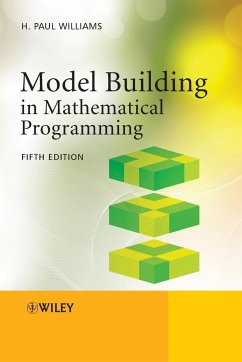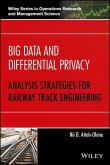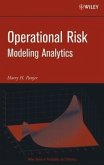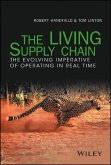H. Paul Williams
Model Building in Mathematical Programming
H. Paul Williams
Model Building in Mathematical Programming
- Broschiertes Buch
- Merkliste
- Auf die Merkliste
- Bewerten Bewerten
- Teilen
- Produkt teilen
- Produkterinnerung
- Produkterinnerung
The 5th edition of Model Building in Mathematical Programming discusses the general principles of model building in mathematical programming and demonstrates how they can be applied by using several simplified but practical problems from widely different contexts. Suggested formulations and solutions are given together with some computational experience to give the reader a feel for the computational difficulty of solving that particular type of model. Furthermore, this book illustrates the scope and limitations of mathematical programming, and shows how it can be applied to real situations.…mehr
Andere Kunden interessierten sich auch für
![Big Data and Differential Privacy Big Data and Differential Privacy]() Nii O. Attoh-OkineBig Data and Differential Privacy139,99 €
Nii O. Attoh-OkineBig Data and Differential Privacy139,99 €![Operational Risk Operational Risk]() Harry H. PanjerOperational Risk160,99 €
Harry H. PanjerOperational Risk160,99 €![Service Science Service Science]() Robin G. QiuService Science133,99 €
Robin G. QiuService Science133,99 €![Airline Network Planning and Scheduling Airline Network Planning and Scheduling]() Ahmed Abdel-GhanyAirline Network Planning and Scheduling125,99 €
Ahmed Abdel-GhanyAirline Network Planning and Scheduling125,99 €![The Living Supply Chain The Living Supply Chain]() Robert HandfieldThe Living Supply Chain94,99 €
Robert HandfieldThe Living Supply Chain94,99 €![A Handbook on Multi-Attribute Decision-Making Methods A Handbook on Multi-Attribute Decision-Making Methods]() Omid Bozorg-HaddadA Handbook on Multi-Attribute Decision-Making Methods120,99 €
Omid Bozorg-HaddadA Handbook on Multi-Attribute Decision-Making Methods120,99 €![Engineering Principles of Combat Modeling and Distributed Simulation Engineering Principles of Combat Modeling and Distributed Simulation]() Andreas TolkEngineering Principles of Combat Modeling and Distributed Simulation155,99 €
Andreas TolkEngineering Principles of Combat Modeling and Distributed Simulation155,99 €-
-
-
The 5th edition of Model Building in Mathematical Programming discusses the general principles of model building in mathematical programming and demonstrates how they can be applied by using several simplified but practical problems from widely different contexts. Suggested formulations and solutions are given together with some computational experience to give the reader a feel for the computational difficulty of solving that particular type of model. Furthermore, this book illustrates the scope and limitations of mathematical programming, and shows how it can be applied to real situations. By emphasizing the importance of the building and interpreting of models rather than the solution process, the author attempts to fill a gap left by the many works which concentrate on the algorithmic side of the subject.
Produktdetails
- Produktdetails
- Verlag: Wiley & Sons
- Artikelnr. des Verlages: 1W118443330
- 5. Aufl.
- Seitenzahl: 432
- Erscheinungstermin: 22. Februar 2013
- Englisch
- Abmessung: 229mm x 152mm x 24mm
- Gewicht: 547g
- ISBN-13: 9781118443330
- ISBN-10: 1118443330
- Artikelnr.: 36631856
- Herstellerkennzeichnung
- Libri GmbH
- Europaallee 1
- 36244 Bad Hersfeld
- gpsr@libri.de
- Verlag: Wiley & Sons
- Artikelnr. des Verlages: 1W118443330
- 5. Aufl.
- Seitenzahl: 432
- Erscheinungstermin: 22. Februar 2013
- Englisch
- Abmessung: 229mm x 152mm x 24mm
- Gewicht: 547g
- ISBN-13: 9781118443330
- ISBN-10: 1118443330
- Artikelnr.: 36631856
- Herstellerkennzeichnung
- Libri GmbH
- Europaallee 1
- 36244 Bad Hersfeld
- gpsr@libri.de
H. Paul Williams, London School of Economics, UK.
Preface
PART 1
1 Introduction
1.1 The Concept of a Model
1.2 Mathematical Programming Models
2 Solving Mathematical Programming Models
2.1 Algorithms and Packages
2.2 Practical Considerations
2.3 Decision Support and Expert Systems
2.4 Constraint Programming
3 Building Linear Programming Models
3.1 The Importance of Linearity
3.2 Defining Objectives
3.3 Defining Constraints
3.4 How to Build a Good Model
3.5 The Use of Modelling Languages
4 Structured Linear Programming Models
4.1 Multiple Plant, Product, and Period Models
4.2 Stochastic Programming Models
4.3 Decomposing a Large Model
5 Applications and Special Types of Mathematical Programming Model
5.1 Typical Applications
5.2 Economic Models
5.3 Network Models
5.4 Converting Linear Programs to Networks
6 Interpreting and Using the Solution of a Linear Programming Model
6.1 Validating a Model
6.2 Economic Interpretations
6.3 Sensitivity Analysis and the Stability of a Model
6.4 Further Investigations Using a Model
6.5 Presentation of the Solutions
7 Non-linear Models
7.1 Typical Applications
7.2 Local and Global Optima
7.3 Separable Programming
7.4 Converting a Problem to a Separable Model
8 Integer Programming
8.1 Introduction
8.2 The Applicability of Integer Programming
8.3 Solving Integer Programming Models
9 Building Integer Programming Models I
9.1 The Uses of Discrete Variables
9.2 Logical Conditions and Zero-One Variables
9.3 Special Ordered Sets of Variables
9.4 Extra Conditions Applied to Linear Programming Models
9.5 Special Kinds of Integer Programming Model
9.6 Column Generation
10 Building Integer Programming Models II
10.1 Good and Bad Formulations
10.2 Simplifying an Integer Programming Model
10.3 Economic Information Obtainable by Integer Programming
10.4 Sensitivity Analysis and the Stability of a Model
10.5 When and How to Use Integer Programming
11 The Implementation of a Mathematical Programming System of Planning
11.1 Acceptance and Implementation
11.2 The Unification of Organizational Functions
11.3 Centralization versus Decentralization
11.4 The Collection of Data and the Maintenance of a Model
PART 2
12 The Problems
12.1 Food Manufacture 1
When to buy and how to blend
12.2 Food Manufacture 2
Limiting the number of ingredients and adding extra conditions
12.3 Factory Planning 1
What to make, on what machines, and when
12.4 Factory Planning 2
When should machines be down for maintenance
12.5 Manpower Planning
How to recruit, retrain, make redundant, or overman
12.6 Refinery Optimization
How to run an oil refinery
12.7 Mining
Which pits to work and when to close them down
12.8 Farm Planning
How much to grow and rear
12.9 Economic Planning
How should an economy grow
12.10 Decentralization
How to disperse offices from the capital
12.11 Curve Fitting
Fitting a curve to a set of data points
12.12 Logical Design
Constructing an electronic system with a minimum number of components
12.13 Market Sharing
Assigning retailers to company divisions
12.14 Opencast Mining
How much to excavate
12.15 Tariff Rates (Power Generation)
How to determine tariff rates for the sale of electricity
12.16 Hydro Power
How to generate and combine hydro and thermal electricity generation
12.17 Three-dimensional Noughts and Crosses
A combinatorial problem
12.18 Optimizing a Constraint
Reconstructing an integer programming constraint more simply
12.19 Distribution 1
Which factories and depots to supply which customers
12.20 Depot Location (Distribution 2)
Where should new depots be built
12.21 Agricultural Pricing
What prices to charge for dairy products
12.22 Efficiency Analysis
How to use data envelopment analysis to compare efficiencies of garages
12.23 Milk Collection
How to route and assign milk collection lorries to farms
12.24 Yield Management
What quantities of airline tickets to sell at what prices and what times
12.25 Car Rental 1
How many cars to own and where to locate them
12.26 Car Rental 2
Where should repair capacity be increased
12.27 Lost Baggage Distribution
Which vehicles should go to which customers and in what order
12.28 Protein Folding
How a string of Amino Acids is likely to fold
12.29 Protein Comparison
How similar are two proteins
PART 3
13 Formulation and Discussion of Problems
13.1 Food Manufacture 1
13.2 Food Manufacture 2
13.3 Factory Planning 1
13.4 Factory Planning 2
13.5 Manpower Planning
13.6 Refinery Optimization
13.7 Mining
13.8 Farm Planning
13.9 Economic Planning
13.10 Decentralization
13.11 Curve Fitting
13.12 Logical Design
13.13 Market Sharing
13.14 Opencast Mining
13.15 Tariff Rates (Power Generation)
13.16 Hydro Power
13.17 Three-dimensional Noughts and Crosses
13.18 Optimizing a Constraint
13.19 Distribution 1
13.20 Depot Location (Distribution 2)
13.21 Agricultural Pricing
13.22 Efficiency Analysis
13.23 Milk Collection
13.24 Yield Management
13.25 Car Rental 1
13.26 Car Rental 2
13.27 Lost Baggage Distribution
13.28 Protein Folding
13.29 Protein Comparison
PART 4
14 Solutions to Problems
14.1 Food Manufacture 1
14.2 Food Manufacture 2
14.3 Factory Planning 1
14.4 Factory Planning 2
14.5 Manpower Planning
14.6 Refinery Optimization
14.7 Mining
14.8 Farm Planning
14.9 Economic Planning
14.10 Decentralization
14.11 Curve Fitting
14.12 Logical Design
14.13 Market Sharing
14.14 Opencast Mining
14.15 Tariff Rates (Power Generation)
14.16 Hydro Power
14.17 Three-dimensional Noughts and Crosses
14.18 Optimizing a Constraint
14.19 Distribution 1
14.20 Depot Location (Distribution 2)
14.21 Agricultural Pricing
14.22 Efficiency Analysis
14.23 Milk Collection
14.24 Yield Management
14.25 Car Rental 1
14.26 Car Rental 2
14.27 Lost Baggage Distribution
14.28 Protein Folding
14.29 Protein Comparison
References
Author Index
Subject Index
PART 1
1 Introduction
1.1 The Concept of a Model
1.2 Mathematical Programming Models
2 Solving Mathematical Programming Models
2.1 Algorithms and Packages
2.2 Practical Considerations
2.3 Decision Support and Expert Systems
2.4 Constraint Programming
3 Building Linear Programming Models
3.1 The Importance of Linearity
3.2 Defining Objectives
3.3 Defining Constraints
3.4 How to Build a Good Model
3.5 The Use of Modelling Languages
4 Structured Linear Programming Models
4.1 Multiple Plant, Product, and Period Models
4.2 Stochastic Programming Models
4.3 Decomposing a Large Model
5 Applications and Special Types of Mathematical Programming Model
5.1 Typical Applications
5.2 Economic Models
5.3 Network Models
5.4 Converting Linear Programs to Networks
6 Interpreting and Using the Solution of a Linear Programming Model
6.1 Validating a Model
6.2 Economic Interpretations
6.3 Sensitivity Analysis and the Stability of a Model
6.4 Further Investigations Using a Model
6.5 Presentation of the Solutions
7 Non-linear Models
7.1 Typical Applications
7.2 Local and Global Optima
7.3 Separable Programming
7.4 Converting a Problem to a Separable Model
8 Integer Programming
8.1 Introduction
8.2 The Applicability of Integer Programming
8.3 Solving Integer Programming Models
9 Building Integer Programming Models I
9.1 The Uses of Discrete Variables
9.2 Logical Conditions and Zero-One Variables
9.3 Special Ordered Sets of Variables
9.4 Extra Conditions Applied to Linear Programming Models
9.5 Special Kinds of Integer Programming Model
9.6 Column Generation
10 Building Integer Programming Models II
10.1 Good and Bad Formulations
10.2 Simplifying an Integer Programming Model
10.3 Economic Information Obtainable by Integer Programming
10.4 Sensitivity Analysis and the Stability of a Model
10.5 When and How to Use Integer Programming
11 The Implementation of a Mathematical Programming System of Planning
11.1 Acceptance and Implementation
11.2 The Unification of Organizational Functions
11.3 Centralization versus Decentralization
11.4 The Collection of Data and the Maintenance of a Model
PART 2
12 The Problems
12.1 Food Manufacture 1
When to buy and how to blend
12.2 Food Manufacture 2
Limiting the number of ingredients and adding extra conditions
12.3 Factory Planning 1
What to make, on what machines, and when
12.4 Factory Planning 2
When should machines be down for maintenance
12.5 Manpower Planning
How to recruit, retrain, make redundant, or overman
12.6 Refinery Optimization
How to run an oil refinery
12.7 Mining
Which pits to work and when to close them down
12.8 Farm Planning
How much to grow and rear
12.9 Economic Planning
How should an economy grow
12.10 Decentralization
How to disperse offices from the capital
12.11 Curve Fitting
Fitting a curve to a set of data points
12.12 Logical Design
Constructing an electronic system with a minimum number of components
12.13 Market Sharing
Assigning retailers to company divisions
12.14 Opencast Mining
How much to excavate
12.15 Tariff Rates (Power Generation)
How to determine tariff rates for the sale of electricity
12.16 Hydro Power
How to generate and combine hydro and thermal electricity generation
12.17 Three-dimensional Noughts and Crosses
A combinatorial problem
12.18 Optimizing a Constraint
Reconstructing an integer programming constraint more simply
12.19 Distribution 1
Which factories and depots to supply which customers
12.20 Depot Location (Distribution 2)
Where should new depots be built
12.21 Agricultural Pricing
What prices to charge for dairy products
12.22 Efficiency Analysis
How to use data envelopment analysis to compare efficiencies of garages
12.23 Milk Collection
How to route and assign milk collection lorries to farms
12.24 Yield Management
What quantities of airline tickets to sell at what prices and what times
12.25 Car Rental 1
How many cars to own and where to locate them
12.26 Car Rental 2
Where should repair capacity be increased
12.27 Lost Baggage Distribution
Which vehicles should go to which customers and in what order
12.28 Protein Folding
How a string of Amino Acids is likely to fold
12.29 Protein Comparison
How similar are two proteins
PART 3
13 Formulation and Discussion of Problems
13.1 Food Manufacture 1
13.2 Food Manufacture 2
13.3 Factory Planning 1
13.4 Factory Planning 2
13.5 Manpower Planning
13.6 Refinery Optimization
13.7 Mining
13.8 Farm Planning
13.9 Economic Planning
13.10 Decentralization
13.11 Curve Fitting
13.12 Logical Design
13.13 Market Sharing
13.14 Opencast Mining
13.15 Tariff Rates (Power Generation)
13.16 Hydro Power
13.17 Three-dimensional Noughts and Crosses
13.18 Optimizing a Constraint
13.19 Distribution 1
13.20 Depot Location (Distribution 2)
13.21 Agricultural Pricing
13.22 Efficiency Analysis
13.23 Milk Collection
13.24 Yield Management
13.25 Car Rental 1
13.26 Car Rental 2
13.27 Lost Baggage Distribution
13.28 Protein Folding
13.29 Protein Comparison
PART 4
14 Solutions to Problems
14.1 Food Manufacture 1
14.2 Food Manufacture 2
14.3 Factory Planning 1
14.4 Factory Planning 2
14.5 Manpower Planning
14.6 Refinery Optimization
14.7 Mining
14.8 Farm Planning
14.9 Economic Planning
14.10 Decentralization
14.11 Curve Fitting
14.12 Logical Design
14.13 Market Sharing
14.14 Opencast Mining
14.15 Tariff Rates (Power Generation)
14.16 Hydro Power
14.17 Three-dimensional Noughts and Crosses
14.18 Optimizing a Constraint
14.19 Distribution 1
14.20 Depot Location (Distribution 2)
14.21 Agricultural Pricing
14.22 Efficiency Analysis
14.23 Milk Collection
14.24 Yield Management
14.25 Car Rental 1
14.26 Car Rental 2
14.27 Lost Baggage Distribution
14.28 Protein Folding
14.29 Protein Comparison
References
Author Index
Subject Index
Preface
PART 1
1 Introduction
1.1 The Concept of a Model
1.2 Mathematical Programming Models
2 Solving Mathematical Programming Models
2.1 Algorithms and Packages
2.2 Practical Considerations
2.3 Decision Support and Expert Systems
2.4 Constraint Programming
3 Building Linear Programming Models
3.1 The Importance of Linearity
3.2 Defining Objectives
3.3 Defining Constraints
3.4 How to Build a Good Model
3.5 The Use of Modelling Languages
4 Structured Linear Programming Models
4.1 Multiple Plant, Product, and Period Models
4.2 Stochastic Programming Models
4.3 Decomposing a Large Model
5 Applications and Special Types of Mathematical Programming Model
5.1 Typical Applications
5.2 Economic Models
5.3 Network Models
5.4 Converting Linear Programs to Networks
6 Interpreting and Using the Solution of a Linear Programming Model
6.1 Validating a Model
6.2 Economic Interpretations
6.3 Sensitivity Analysis and the Stability of a Model
6.4 Further Investigations Using a Model
6.5 Presentation of the Solutions
7 Non-linear Models
7.1 Typical Applications
7.2 Local and Global Optima
7.3 Separable Programming
7.4 Converting a Problem to a Separable Model
8 Integer Programming
8.1 Introduction
8.2 The Applicability of Integer Programming
8.3 Solving Integer Programming Models
9 Building Integer Programming Models I
9.1 The Uses of Discrete Variables
9.2 Logical Conditions and Zero-One Variables
9.3 Special Ordered Sets of Variables
9.4 Extra Conditions Applied to Linear Programming Models
9.5 Special Kinds of Integer Programming Model
9.6 Column Generation
10 Building Integer Programming Models II
10.1 Good and Bad Formulations
10.2 Simplifying an Integer Programming Model
10.3 Economic Information Obtainable by Integer Programming
10.4 Sensitivity Analysis and the Stability of a Model
10.5 When and How to Use Integer Programming
11 The Implementation of a Mathematical Programming System of Planning
11.1 Acceptance and Implementation
11.2 The Unification of Organizational Functions
11.3 Centralization versus Decentralization
11.4 The Collection of Data and the Maintenance of a Model
PART 2
12 The Problems
12.1 Food Manufacture 1
When to buy and how to blend
12.2 Food Manufacture 2
Limiting the number of ingredients and adding extra conditions
12.3 Factory Planning 1
What to make, on what machines, and when
12.4 Factory Planning 2
When should machines be down for maintenance
12.5 Manpower Planning
How to recruit, retrain, make redundant, or overman
12.6 Refinery Optimization
How to run an oil refinery
12.7 Mining
Which pits to work and when to close them down
12.8 Farm Planning
How much to grow and rear
12.9 Economic Planning
How should an economy grow
12.10 Decentralization
How to disperse offices from the capital
12.11 Curve Fitting
Fitting a curve to a set of data points
12.12 Logical Design
Constructing an electronic system with a minimum number of components
12.13 Market Sharing
Assigning retailers to company divisions
12.14 Opencast Mining
How much to excavate
12.15 Tariff Rates (Power Generation)
How to determine tariff rates for the sale of electricity
12.16 Hydro Power
How to generate and combine hydro and thermal electricity generation
12.17 Three-dimensional Noughts and Crosses
A combinatorial problem
12.18 Optimizing a Constraint
Reconstructing an integer programming constraint more simply
12.19 Distribution 1
Which factories and depots to supply which customers
12.20 Depot Location (Distribution 2)
Where should new depots be built
12.21 Agricultural Pricing
What prices to charge for dairy products
12.22 Efficiency Analysis
How to use data envelopment analysis to compare efficiencies of garages
12.23 Milk Collection
How to route and assign milk collection lorries to farms
12.24 Yield Management
What quantities of airline tickets to sell at what prices and what times
12.25 Car Rental 1
How many cars to own and where to locate them
12.26 Car Rental 2
Where should repair capacity be increased
12.27 Lost Baggage Distribution
Which vehicles should go to which customers and in what order
12.28 Protein Folding
How a string of Amino Acids is likely to fold
12.29 Protein Comparison
How similar are two proteins
PART 3
13 Formulation and Discussion of Problems
13.1 Food Manufacture 1
13.2 Food Manufacture 2
13.3 Factory Planning 1
13.4 Factory Planning 2
13.5 Manpower Planning
13.6 Refinery Optimization
13.7 Mining
13.8 Farm Planning
13.9 Economic Planning
13.10 Decentralization
13.11 Curve Fitting
13.12 Logical Design
13.13 Market Sharing
13.14 Opencast Mining
13.15 Tariff Rates (Power Generation)
13.16 Hydro Power
13.17 Three-dimensional Noughts and Crosses
13.18 Optimizing a Constraint
13.19 Distribution 1
13.20 Depot Location (Distribution 2)
13.21 Agricultural Pricing
13.22 Efficiency Analysis
13.23 Milk Collection
13.24 Yield Management
13.25 Car Rental 1
13.26 Car Rental 2
13.27 Lost Baggage Distribution
13.28 Protein Folding
13.29 Protein Comparison
PART 4
14 Solutions to Problems
14.1 Food Manufacture 1
14.2 Food Manufacture 2
14.3 Factory Planning 1
14.4 Factory Planning 2
14.5 Manpower Planning
14.6 Refinery Optimization
14.7 Mining
14.8 Farm Planning
14.9 Economic Planning
14.10 Decentralization
14.11 Curve Fitting
14.12 Logical Design
14.13 Market Sharing
14.14 Opencast Mining
14.15 Tariff Rates (Power Generation)
14.16 Hydro Power
14.17 Three-dimensional Noughts and Crosses
14.18 Optimizing a Constraint
14.19 Distribution 1
14.20 Depot Location (Distribution 2)
14.21 Agricultural Pricing
14.22 Efficiency Analysis
14.23 Milk Collection
14.24 Yield Management
14.25 Car Rental 1
14.26 Car Rental 2
14.27 Lost Baggage Distribution
14.28 Protein Folding
14.29 Protein Comparison
References
Author Index
Subject Index
PART 1
1 Introduction
1.1 The Concept of a Model
1.2 Mathematical Programming Models
2 Solving Mathematical Programming Models
2.1 Algorithms and Packages
2.2 Practical Considerations
2.3 Decision Support and Expert Systems
2.4 Constraint Programming
3 Building Linear Programming Models
3.1 The Importance of Linearity
3.2 Defining Objectives
3.3 Defining Constraints
3.4 How to Build a Good Model
3.5 The Use of Modelling Languages
4 Structured Linear Programming Models
4.1 Multiple Plant, Product, and Period Models
4.2 Stochastic Programming Models
4.3 Decomposing a Large Model
5 Applications and Special Types of Mathematical Programming Model
5.1 Typical Applications
5.2 Economic Models
5.3 Network Models
5.4 Converting Linear Programs to Networks
6 Interpreting and Using the Solution of a Linear Programming Model
6.1 Validating a Model
6.2 Economic Interpretations
6.3 Sensitivity Analysis and the Stability of a Model
6.4 Further Investigations Using a Model
6.5 Presentation of the Solutions
7 Non-linear Models
7.1 Typical Applications
7.2 Local and Global Optima
7.3 Separable Programming
7.4 Converting a Problem to a Separable Model
8 Integer Programming
8.1 Introduction
8.2 The Applicability of Integer Programming
8.3 Solving Integer Programming Models
9 Building Integer Programming Models I
9.1 The Uses of Discrete Variables
9.2 Logical Conditions and Zero-One Variables
9.3 Special Ordered Sets of Variables
9.4 Extra Conditions Applied to Linear Programming Models
9.5 Special Kinds of Integer Programming Model
9.6 Column Generation
10 Building Integer Programming Models II
10.1 Good and Bad Formulations
10.2 Simplifying an Integer Programming Model
10.3 Economic Information Obtainable by Integer Programming
10.4 Sensitivity Analysis and the Stability of a Model
10.5 When and How to Use Integer Programming
11 The Implementation of a Mathematical Programming System of Planning
11.1 Acceptance and Implementation
11.2 The Unification of Organizational Functions
11.3 Centralization versus Decentralization
11.4 The Collection of Data and the Maintenance of a Model
PART 2
12 The Problems
12.1 Food Manufacture 1
When to buy and how to blend
12.2 Food Manufacture 2
Limiting the number of ingredients and adding extra conditions
12.3 Factory Planning 1
What to make, on what machines, and when
12.4 Factory Planning 2
When should machines be down for maintenance
12.5 Manpower Planning
How to recruit, retrain, make redundant, or overman
12.6 Refinery Optimization
How to run an oil refinery
12.7 Mining
Which pits to work and when to close them down
12.8 Farm Planning
How much to grow and rear
12.9 Economic Planning
How should an economy grow
12.10 Decentralization
How to disperse offices from the capital
12.11 Curve Fitting
Fitting a curve to a set of data points
12.12 Logical Design
Constructing an electronic system with a minimum number of components
12.13 Market Sharing
Assigning retailers to company divisions
12.14 Opencast Mining
How much to excavate
12.15 Tariff Rates (Power Generation)
How to determine tariff rates for the sale of electricity
12.16 Hydro Power
How to generate and combine hydro and thermal electricity generation
12.17 Three-dimensional Noughts and Crosses
A combinatorial problem
12.18 Optimizing a Constraint
Reconstructing an integer programming constraint more simply
12.19 Distribution 1
Which factories and depots to supply which customers
12.20 Depot Location (Distribution 2)
Where should new depots be built
12.21 Agricultural Pricing
What prices to charge for dairy products
12.22 Efficiency Analysis
How to use data envelopment analysis to compare efficiencies of garages
12.23 Milk Collection
How to route and assign milk collection lorries to farms
12.24 Yield Management
What quantities of airline tickets to sell at what prices and what times
12.25 Car Rental 1
How many cars to own and where to locate them
12.26 Car Rental 2
Where should repair capacity be increased
12.27 Lost Baggage Distribution
Which vehicles should go to which customers and in what order
12.28 Protein Folding
How a string of Amino Acids is likely to fold
12.29 Protein Comparison
How similar are two proteins
PART 3
13 Formulation and Discussion of Problems
13.1 Food Manufacture 1
13.2 Food Manufacture 2
13.3 Factory Planning 1
13.4 Factory Planning 2
13.5 Manpower Planning
13.6 Refinery Optimization
13.7 Mining
13.8 Farm Planning
13.9 Economic Planning
13.10 Decentralization
13.11 Curve Fitting
13.12 Logical Design
13.13 Market Sharing
13.14 Opencast Mining
13.15 Tariff Rates (Power Generation)
13.16 Hydro Power
13.17 Three-dimensional Noughts and Crosses
13.18 Optimizing a Constraint
13.19 Distribution 1
13.20 Depot Location (Distribution 2)
13.21 Agricultural Pricing
13.22 Efficiency Analysis
13.23 Milk Collection
13.24 Yield Management
13.25 Car Rental 1
13.26 Car Rental 2
13.27 Lost Baggage Distribution
13.28 Protein Folding
13.29 Protein Comparison
PART 4
14 Solutions to Problems
14.1 Food Manufacture 1
14.2 Food Manufacture 2
14.3 Factory Planning 1
14.4 Factory Planning 2
14.5 Manpower Planning
14.6 Refinery Optimization
14.7 Mining
14.8 Farm Planning
14.9 Economic Planning
14.10 Decentralization
14.11 Curve Fitting
14.12 Logical Design
14.13 Market Sharing
14.14 Opencast Mining
14.15 Tariff Rates (Power Generation)
14.16 Hydro Power
14.17 Three-dimensional Noughts and Crosses
14.18 Optimizing a Constraint
14.19 Distribution 1
14.20 Depot Location (Distribution 2)
14.21 Agricultural Pricing
14.22 Efficiency Analysis
14.23 Milk Collection
14.24 Yield Management
14.25 Car Rental 1
14.26 Car Rental 2
14.27 Lost Baggage Distribution
14.28 Protein Folding
14.29 Protein Comparison
References
Author Index
Subject Index









